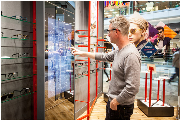 Zytronic has built up a widely recognised brand – producing responsive, accurate and durable touch sensors of sizeable proportions. Through the success of these sensors, based on its patented Projective Capacitive Technology (PCT), the company now boasts an expansive client base, as well as a series of industry awards. Furthermore, the array of end applications its products have been specified for is growing constantly.
Zytronic has built up a widely recognised brand – producing responsive, accurate and durable touch sensors of sizeable proportions. Through the success of these sensors, based on its patented Projective Capacitive Technology (PCT), the company now boasts an expansive client base, as well as a series of industry awards. Furthermore, the array of end applications its products have been specified for is growing constantly.
One area of increasing interest is putting touchscreen functionality into reflective surfaces. This is seeing significant uptake in both domestic and retail sectors. Through its integration partner Display Technology, Zytronic’s proprietary sensing technology has been involved in a recent deployment of this kind, carried out for high street optician Kite GB.
The touch-enabled point of sale unit located at Kite’s flagship store in London’s East End utilises a PCT touch sensor with a 42in active area, sourced from Zytronic. The sensor has been applied to mirror-finished toughened glass and is capable of supporting up to 40-point multi-touch operation. Via the unit, customers are able to take photos of themselves wearing different frames, then post them on Twitter, Facebook, Instagram and other social media platforms – so that their friends and family can look at the chosen frames and give their opinions.
In addition to the Zytronic PCT sensor, the system consists of an ultra-thin LCD digital signage monitor, supplied by Display Technology, with high brightness output, 1920×1080 pixel resolution and wide viewing angle. Moreover, the Logitech HD Pro C920 web camera provides high resolution photos and video that can be stored on the host PC, then manipulated and subsequently uploaded. The customised software facilitates social interaction and the sharing of content with others.
Zytronic’s PCT touch sensors rely on a matrix of 10µm thick copper capacitors, in an XY configuration, embedded inside a laminated substrate. This protects the sensor matrix from sources of damage, such as scratches, impacts, extreme temperatures and exposure to harsh chemicals that often compromise the lifespan of touch sensors based on resistive and surface capacitive technologies. Likewise, in contrast to infrared (IR), optical and surface acoustic wave (SAW) technologies, PCT negates the need for a bezel in which to accommodate sensors/emitters, so that sleek, attractive, smooth-fronted designs can be realised. This is particularly in keeping with the aesthetic demands of the Kite project.
As Asad Hamir, Kite GB CEO, explained: “The vast majority of dispensing opticians haven’t considered how technology can help them engage with their customers. We really wanted to enhance the user experience and provide an environment that is conducive to social sharing. The unit is already proving very popular and is a great differentiator for Kite. It allows customers to get advice on the products they are thinking about purchasing from the people that matter most to them, not just the store staff.”
“The two-phase mirror function is extremely advantageous for the Kite unit. It gives it the appearance of an elegant silver mirror when the monitor is not lit, consistent with the decor of the store. It then becomes instantly transparent when the monitor is activated, so that an intuitive touchscreen interface materialises,” added Ian Crosby, Zytronic’s sales and marketing director. “PCT is fast becoming the sensor solution of choice for those looking to integrate touchscreens touch sensing across large mirrored surfaces. Its combination of strong touch performance and unmatched operational longevity, along with provision for multi-touch operation, make it very compelling.”



